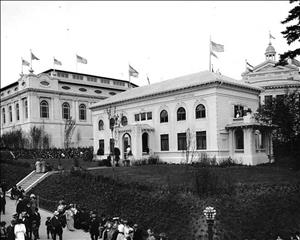In 1909, the Woman's Building on the University of Washington campus opened as part of the Alaska-Yukon-Pacific Exposition to showcase women's art and to provide hospitality to visiting women. It then served as a center for campus and community women until 1916, when it was put to other use.
After the 19th Amendment to the U. S. Constitution granted women the right to vote in 1920, younger women thought they had gained full equality with men and that they no longer needed a strong women's network. They gradually forgot about the building. Decades later, a resurgent feminist movement sparked its rediscovery. Women reclaimed the building in the early 1980s and named it Cunningham Hall for Imogen Cunningham (1883-1976), a pioneering artistic portrait photographer. It now houses the Women's Information Center and the Northwest Center for Research on Women.
The Alaska-Yukon-Pacific Exposition was held in 1909 on the new University of Washington campus, and like every major American fair, it had its women's building. The Washington State Federation of Women's Clubs had successfully lobbied the legislature for the building. Its purpose was to celebrate women's accomplishments and provide hospitality for visiting women.
The two-story, wooden structure housed a student YWCA-sponsored restaurant that served five-cent lunches, a nursery that provided care for as many as 300 children a day, a juried exhibition of Washington women's art, and a meeting hall. Washington club women used the building to host receptions for members of the National American Woman Suffrage Association, the National Council of Women, and other organizations that held their annual conventions in Seattle.
After the fair, the building, as planned, became an activity center for campus women. It housed the office of the dean of women, the campus Women's League, the Tolo Club (a senior honorary society that later affiliated with Mortar Board), the Sacajewea and Athena debating teams, the Sororia Society for mature women students, and the student YWCA. Campus women successfully lobbied for the letter "W" for women athletes in basketball, rowing, tennis, hockey, handball, and baseball.
Seattle club women also met at the building, where they socialized with women students and recruited them for their causes. For decades women as non-voters formed women's clubs to plan and carry out numerous worthwhile projects. They needed younger women to perpetuate their public reform efforts. They recruited student volunteers to work in hospitals and social service agencies. Campus and community women worked together to devise campaign strategies for suffrage, prohibition, and other women's issues.
Jeanette Rankin (1880-1973), the first female member of the U.S. Congress, was a University of Washington graduate student who received her introduction to politics at the Woman's Building. She gave her first political speech to a group of six at a street-side suffrage rally in northwest Seattle's Ballard neighborhood. On return to her native Montana, voters elected her as the first woman representative in Congress. She was officially seated in April 1917. A pacifist, she was the only member of congress to vote against America's entry into both world wars.
In 1917 while Rankin cast her vote, the U.S. government commandeered the Woman's Building to support the war effort. Campus and community women made numerous efforts to obtain an alternate space, but their pleas fell on deaf ears.
Another conundrum was women's interpretation of their right to vote. With the enactment of suffrage, many women thought that they had gained full equality with men and that they no longer needed outmoded women's networks. The suffrage crusade had acted as a magnet, uniting women of different backgrounds. Having achieved their goal, women and women's groups throughout the nation went their separate ways.
The Woman's Building was subsequently forgotten. It was named Johnson Hall Annex B and was used for storage. In the 1980s, women historians rediscovered its history. In keeping with a resurgent women's movement, women's organizations pressured the university to reclaim their building. Emerging from decades of neglect, it was cleaned up and given a badly needed face lift.
A crowd of campus and community women gathered on May 10, 1983, for the Woman's Building's rededication as Cunningham Hall. It is named for Imogen Cunningham (1883-1976), the pioneering artistic portrait photographer who graduated from the University of Washington in 1907 and inspired generations with her work and spirit.
Ironically, the rededication sparked protest demonstrations. The University's newly announced budget cuts included dental hygiene, textiles, and children's drama, all of which were women-dominated programs. Protesters heckled President William Gerberding with picket signs that labeled restoration of the building as mere tokenism. According to one historian, both the building and the demonstration symbolized renewed appeal of an ideology that had lain dormant for half a century: "The old formula, which called for sisterly cooperation in Seattle as elsewhere, was revitalized" (Blair, 80).
Today, Cunningham Hall houses the Women's Information Center, which serves both campus and community women. It houses the Northwest Center for Research on Women, rotating juried exhibits by women artists, and a conference room. Once again, the Washington State Federation of Women's Clubs contributes to its support, including donating books for the center's library.
On September 16, 2009, Cunningham Hall was relocated in order to make way for the construction of a new 89,000-square-foot molecular engineering building. Cunningham Hall now sits just west of Parrington Hall, facing George Washington Lane.

